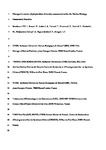Changes in marine phytoplankton diversity: Assessment under the Marine Strategy Framework Directive
| dc.contributor.author | McQuatters-Gollop, AL | |
| dc.contributor.author | Rombouts, I | |
| dc.date.accessioned | 2019-03-04T14:01:19Z | |
| dc.date.issued | 2019-07 | |
| dc.identifier.issn | 1470-160X | |
| dc.identifier.issn | 1872-7034 | |
| dc.identifier.uri | http://hdl.handle.net/10026.1/13401 | |
| dc.description | Publisher’s embargo period: Embargo set on 11.03.2019 by SR (TIS). | |
| dc.description.abstract |
The Marine Strategy Framework Directive requires EU Member States to assess the Good Environmental Status (GES) of their marine waters in a coherent and strategic manner. For the regional assessment of biodiversity, the OSPAR Intersessional Coordination Group of Biodiversity Assessment and Monitoring (ICG-COBAM) provides substantial advice. Through expert working groups, phytoplankton indicators are currently being developed to measure the state and the change in pelagic diversity, to quantify food web dynamics and to measure the extent of eutrophication impacts. We developed a multi-metric indicator that is compliant with the common OSPAR indicator “Changes in plankton diversity” (PH3). The aim was to describe the structure of the phytoplankton community (alpha diversity) and to detect significant temporal changes (beta diversity) to evaluate the health of pelagic habitats. In this pilot study, we used three coastal time-series in the Western Channel and the north of the Bay of Biscay (North Atlantic, France) to test the efficiency and the performance of several existing diversity indices. We validated two alpha diversity indices, namely the Menhinick Index (D) and the Hulburt Index (δ), based on their complementary ecological information, their strong relationship with habitat characteristics, and their relative ease of interpretation for stakeholders. Temporal shifts or rate of change in community structure were detected by the Local Contributions to Beta Diversity index (LCBD; a beta diversity measure). For the years where significantly high LCBD values were found, the Importance Value Index (IVI) was calculated to potentially identify the taxa (genus) responsible for the “unusual” community structure. For example, at the Ouest Loscolo site in 2008, an elevated LCBD (0.45) coincided with a high dominance value (Hulburt's Index) caused by the occurrence of a monospecific bloom of Leptocylindrus spp. (IVI = 73%) in July (2.22 × 10 6 cells L −1 ) and October (8 × 10 6 cells L −1 ). In this way, PH3 informs on different aspects of phytoplankton diversity from a community to a genus level. At the current stage of development, however, PH3 acts as a “surveillance” rather than an operational indicator since the relationship to GES is not directly tracked. In the future, by additional testing of PH3 and extending the geographical scope, the robustness of the assessment could be further determined across the OSPAR Maritime Area. | |
| dc.format.extent | 265-277 | |
| dc.language | en | |
| dc.language.iso | en | |
| dc.publisher | Elsevier | |
| dc.subject | Community composition | |
| dc.subject | Good Environmental Status | |
| dc.subject | Indicators | |
| dc.subject | Marine policy | |
| dc.subject | MSFD | |
| dc.subject | OSPAR | |
| dc.subject | Pelagic habitat | |
| dc.subject | Plankton | |
| dc.title | Changes in marine phytoplankton diversity: Assessment under the Marine Strategy Framework Directive | |
| dc.type | journal-article | |
| dc.type | Article | |
| plymouth.author-url | https://www.webofscience.com/api/gateway?GWVersion=2&SrcApp=PARTNER_APP&SrcAuth=LinksAMR&KeyUT=WOS:000470964500026&DestLinkType=FullRecord&DestApp=ALL_WOS&UsrCustomerID=11bb513d99f797142bcfeffcc58ea008 | |
| plymouth.volume | 102 | |
| plymouth.publication-status | Published | |
| plymouth.journal | Ecological Indicators | |
| dc.identifier.doi | 10.1016/j.ecolind.2019.02.009 | |
| plymouth.organisational-group | /Plymouth | |
| plymouth.organisational-group | /Plymouth/Faculty of Science and Engineering | |
| plymouth.organisational-group | /Plymouth/Faculty of Science and Engineering/School of Biological and Marine Sciences | |
| plymouth.organisational-group | /Plymouth/REF 2021 Researchers by UoA | |
| plymouth.organisational-group | /Plymouth/REF 2021 Researchers by UoA/UoA07 Earth Systems and Environmental Sciences | |
| plymouth.organisational-group | /Plymouth/Users by role | |
| plymouth.organisational-group | /Plymouth/Users by role/Academics | |
| plymouth.organisational-group | /Plymouth/Users by role/Researchers in ResearchFish submission | |
| dcterms.dateAccepted | 2019-02-08 | |
| dc.rights.embargodate | 2020-2-27 | |
| dc.identifier.eissn | 1872-7034 | |
| dc.rights.embargoperiod | Not known | |
| rioxxterms.versionofrecord | 10.1016/j.ecolind.2019.02.009 | |
| rioxxterms.licenseref.uri | http://www.rioxx.net/licenses/all-rights-reserved | |
| rioxxterms.licenseref.startdate | 2019-07 | |
| rioxxterms.type | Journal Article/Review | |
| plymouth.funder | Plankton science for supporting the implementation of marine ecosystem-based management and conservation::NERC | |
| plymouth.funder | Plankton science for supporting the implementation of marine ecosystem-based management and conservation::NERC | |
| plymouth.funder | Plankton science for supporting the implementation of marine ecosystem-based management and conservation::NERC |


